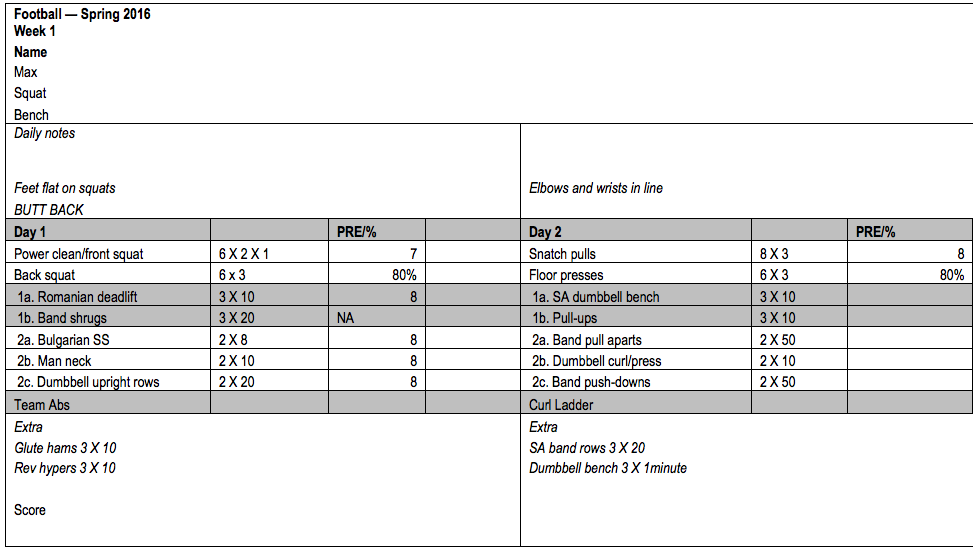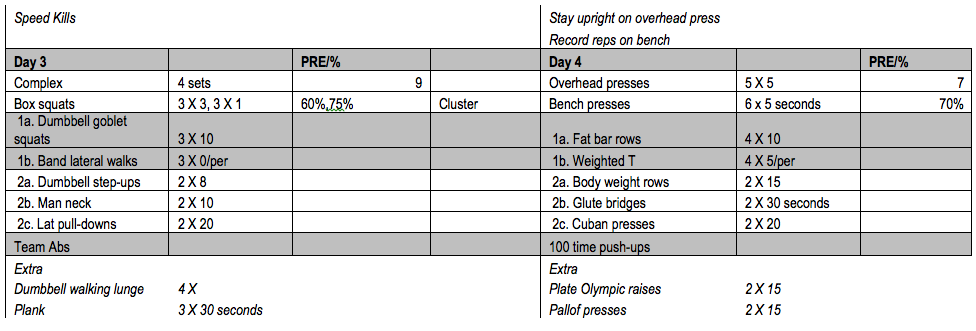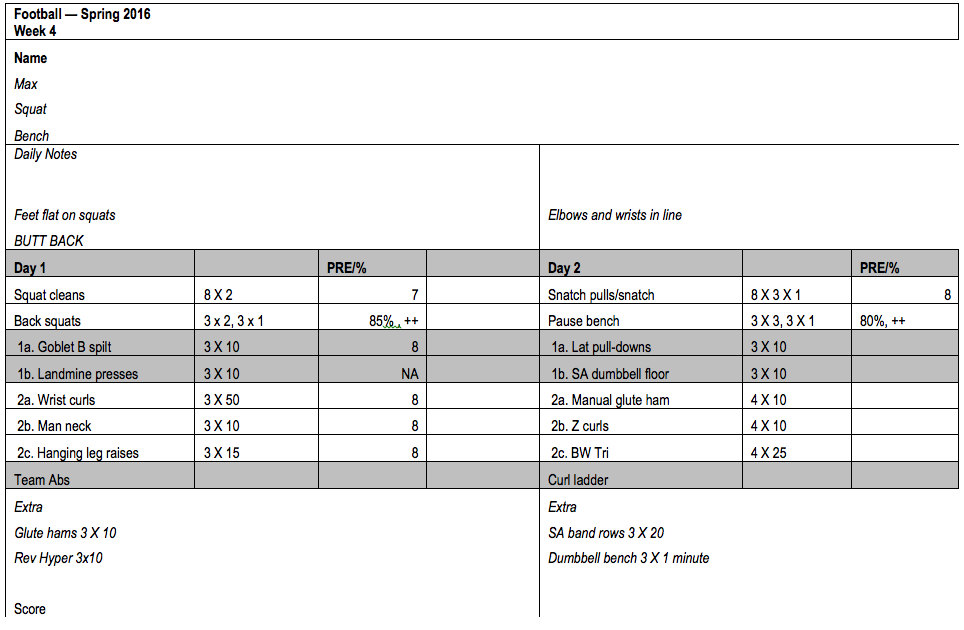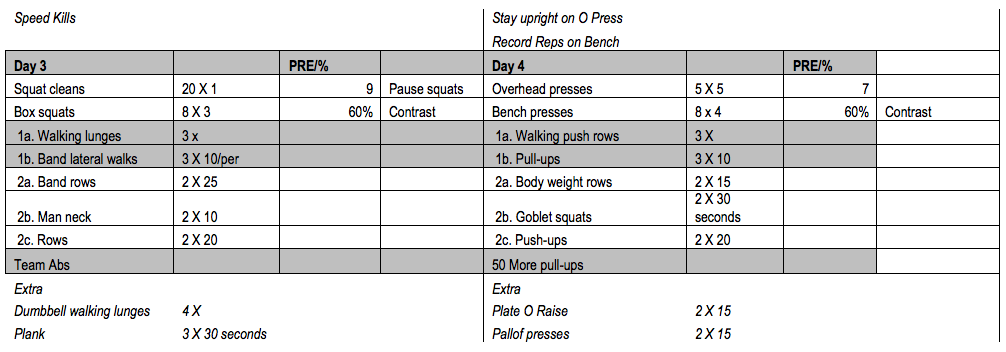
Any strength professional who works with football knows that a great time to train and make some good strength gains is from the beginning of the spring semester until spring ball starts. For a school like the one I work at, it's the most important five to six weeks one can imagine. This time is so important to me because we don't have our entire team here in the summer, so this is the only time when I can really work with the team and not worry about anything other than training.
As this time comes to a close, many of us (me included) post videos showing how great we are as coaches: Look at me! I took a 225-pound bencher and made him a 250-pound bencher! Or we now have 75 guys who bench 405 pounds (that would be a strong team). What is missing in all this? The work that had to be done to get there! So I've decided to share with you what we did over the last five weeks and why. I realize that by doing this, I'm opening myself up to people telling me how dumb I am. That’s OK. I’ve been told that by many people before, so here we go!
RECENT: You Need A Reality Check
December
Every year, I meet with my head coach to start the off-season. The questions are always a little different but range from "what can we do better?" to "what did we do well?" and "what are our off-season goals?" My head coach loves to simplify what we do. Generally he tells me, “I want to see bench presses go up by 20 pounds and squats by 40 pounds in the next five to six weeks." I know some strength coaches who would say that this is too simple. Remember, we aren't the head coach. We are the support staff, so my goals are clear: test them in January, retest before spring break and average a 20-pound increase in the bench and a 40-pound increase in the squat. It couldn’t be much easier than that, right?
Programming
Last year, I decided (with help from the football staff) to change our lifting days. We lift on Sundays because we have no other distractions on Sundays. Sundays are great for motivating the guys. Who else lifts on Sundays in the off-season? Also, Sunday lifts open the weight room a little for the rest of the week for other teams.
We also train the guys on Mondays, Wednesdays and Fridays. Lifts are scheduled around class schedules, so we only have 47 minutes to train. To make up for our missed accessories, we do blitz lifts on Tuesdays or Thursdays. Our blitz lifts are organized so that the athlete picks his day: Tuesday or Thursday. We offer three, 30-minute time slots on each one of those days (Tuesdays at 10:00 am, 10:30 am and 11:00 am and Thursdays at 12:30 pm, 1:00 pm and 1:30 pm). We do this so that if an athlete has a morning class, he can go on Thursdays, and if he has an afternoon class, he can go on Tuesdays.
The blitz lifts are all circuit based and done for time. For example, athletes might perform 10 exercises at 60 seconds per exercise, for one set through with a partner. The lifts vary based on what I feel we need, and I try to make them fun.
Here is an example of what we did for one of our blitzes:
- Battling ropes
- Dumbbell bench
- Reverse hypers
- Glute ham sit-ups
- Band rows
- Heavy bags
- Sled mills
- Band push-downs
- Curls
- Rolling planks
As with our main lifts (the other four days), we know that our goals are based around the power lifts (this is what our head coach wants). I feel the Olympic lifts have their place and are important so we still do them, but we don’t use percentages or test them. We coach them and use them for speed. Our goals are always good form and good speed, and we aim not to miss and work the full range of motion.
On a side note, some won’t like the terminology I use. With our Olympic lifts, I always make the first word where we catch (e.g. squat or power), the second word is the movement and the final word is where we begin (e.g. hang). So yes, I will say, "Squat snatch from high hang." We never train from below the knee, and we generally go from a power position unless otherwise noted. From there, we move to our power lifts and then all our accessories are supersetted.
Here is what we did.
This was week one for the first three weeks. The biggest changes were that our percentages went up and the reps went down on squats and bench presses. As for accessories, they mainly remain static. I’ll skip ahead to week four so that you aren't just reading Excel sheets.
As you can see, we started to add contrast work into our training at this point. This could be bands or chains, depending on the preparedness of the athlete. After years of doing this, I don't believe that this is a perfect time to add bands or chains, but—and this is a huge but—it excites the athletes more than the straight weight, so if all it does is get buy in, I'll continue to use them. After this, we did one more week of heavy training before cutting back just a little before test time.
One last thing to address before I get to testing is how we warm up or start every lift. I stole something from Bill Hicks of Syracuse. We begin each lift by jogging to the locker room and running the guys into the room. We have four doors between the locker room and the weight room. I have an intern at each door whose job is to clap, motivate and help set the tone of the lift.
Once the team enters the room, we do 10 up downs on my whistle. From there, the athletes run to their rack to begin the team warm up. This changes daily, but most days we have some type of squat (front squat most often). Then we do some back or posterior chain work and either a mobility drill or more back work. We used to do a more traditional warm up until I realized I was losing the mentality that the athletes brought to the room, so now we've cut it down to what I feel we need to be successful.
Testing
We did testing on the Sunday before spring break. We averaged a 19.6-pound increase in the bench, so we didn't quite reach our goal, but we did have a nice improvement. As for the squat, we averaged 46 pounds. I'll be the first to admit that these numbers had more to do with the athletes relearning how to lift than with absolute strength gains. Most of our guys didn't train hard at home over December, so our testing in January was a very low max. If I had to guess, I would say that the numbers are closer to 13 pounds and 30 pounds for actual strength increases. Either way, I'm happy with what we did. While we will change some things next year, I'm sure the basic tenants of what we've been doing won't drastically change.















2 Comments